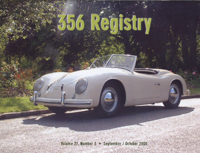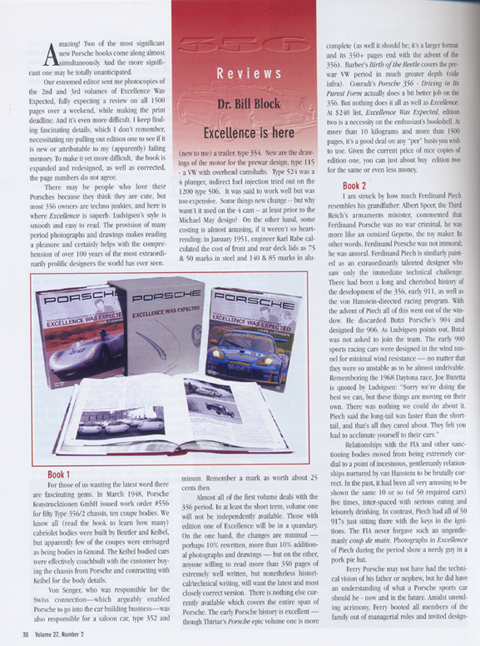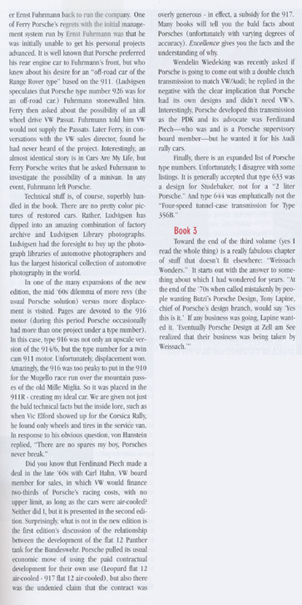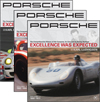|
Porsche: Excellence Was Expected
Price: TBD
|

356 Registry - September/October 2003
Reviews
Dr. Bill Block
Excellence is here
Amazing! Two of the most significant new Porsche books come along almost simultaneously And the more significant one may be totally unanticipated.
Our esteemed editor sent me photocopies of the 2nd and 3rd volumes of Excellence Was Expected, fully expecting a review on all 1500 pages over a weekend, while making the print deadline. And it's even more difficult. I keep finding fascinating details, which I don't remember, necessitating my puffing out edition one to see if it is new or attributable to my (apparently) failing memory. To make it yet more difficult, the book is expanded and redesigned, as well as corrected, the page numbers do not agree.
There may be people who love their Porsches because they think they are cute, but most 356 owners are techno junkies, and here is where Excellence is superb. Ludvigsen's style is smooth and easy to read. The provision of many period photographs and drawings makes reading a pleasure and certainly helps with the comprehension of over 100 years of the most extraordinarily prolific designers the world has ever seen.
Book 1
For those of us wanting the latest word there are fascinating gems. In March 1948, Porsche Konstrucktionen GmbH issued work order #556 for fifty Type 356/2 chassis, ten coupe bodies. We know all (read the book to learn how many) cabriolet bodies were built by Beutler and Keibel, but apparently few of the coupes were envisaged as being bodies in Gmünd. The Keibel bodied cars were effectively coachbuilt with the customer buying the chassis from Porsche and contracting with Keibel for the body details.
Von Senger, who was responsible for the Swiss connection - which arguably enabled Porsche to go into the car building business - was also responsible for a saloon car, type 352 and (new to me) a trailer, type 354. New are the drawings of the motor for the prewar design, type 115 - a VW with overhead camshafts. Type 524 was a 4 plunger, indirect fuel injection tried out on the 1200 type 506. It was said to work well but was too expensive. Some things new change -- but why wasn't it used on the 4 cam -- at least prior to the Michael May design? On the other hand, some costing is almost amusing, if it weren't so heartrending: in January 1951, engineer Karl Rabe calculated the cost of front and rear deck lids as 75 & 50 marks in steel and 140 & 85 marks in aluminum. Remember a mark as worth about 25 cents then.
Almost all of the first volume deals with the 356 period. In at least the short term, volume one will not be independently available. Those with edition one of Excellence will be in a quandary. On the one hand, the changes are minimal?perhaps 10% rewritten, more than 10% additional photographs and drawings?but on the other, anyone willing to read more than 350 pages of extremely well written, but nonetheless historical/technical writing, will want the latest and most closely correct version. There is nothing else currently available which covers the entire span of Porsche. The early Porsche history is excellent?though Thiriar's Porsche epic volume one is more complete (as well it should be; it's a larger format and its 350+ pages end with the advent of the 356). Barber's Birth of the Beetle covers the prewar VW period in much greater depth (vide infra). Conradt's Porsche 356 - Driving in Its Purest Form actually does a bit better job on the 356. But nothing does it all as well as Excellence. At $240 list, Excellence Was Expected, edition two is a necessity on the enthusiast's bookshelf. At more than 10 kilograms and more than 1500 pages, it's a good deal on any "per" basis you wish to use. Given the current price of nice copies of edition one, you can just about buy edition two for the same or even less money.
Book 2
I am struck by how much Ferdinand Piëch resembles his grandfather. Albert Speer, the Third Reich's armaments minister, commented that Ferdinand Porsche was no war criminal, he was more like an outsized Gepetto, the toy maker. In other words, Ferdinand Porsche was not immoral; he was amoral. Ferdinand Piëch is similarly painted as an extraordinarily talented designer who saw only the immediate technical challenge. There had been a long and cherished history of the development of the 356, early 911, as well as the von Hanstein-directed racing program. With the advent of Piëch all of this went out of the window. He discarded Butzi Porsche's 904 and designed the 906. As Ludvigsen points out, Butzi was not asked to join the team. The early 900 sports racing cars were designed in the wind tunnel for minimal wind resistance - no matter that they were so unstable as to be almost undrivable. Remembering the 1968 Daytona race, Joe Buzetta is quoted by Ludvigsen: "Sorry we're doing the best we can, but these things are moving on their own. There was nothing we could do about it. Piëch said the long-tail was faster than the shorttail, and that's all they cared about. They felt you had to acclimate yourself to their cars."
Relationships with the FIA and other sanctioning bodies moved from being extremely cordial to a point of incestuous, gentlemanly relationships nurtured by van Hanstein to be brutally correct. In the past, it had been all very amusing to be shown the same 10 or so (of 50 required cars) five times, inter-spaced with serious eating and leisurely drinking. In contrast, Piëch had all of 50 917s just sitting there with the keys in the ignitions. The FIA never forgave such an ungentlemanly coup de main. Photographs in Excellence of Piëch during the period show a nerdy guy in a pork pie hat.
Ferry Porsche may not have had the technical vision of his father or nephew, but he did have an understanding of what a Porsche sports car should be - now and in the future. Amidst unending acrimony, Ferry booted all members of the family out of managerial roles and invited designer Ernst Fuhrmann back to run the company. One of Ferry Porsche's regrets with the initial management system run by Ernst Fuhrmann was that he was initially unable to get his personal projects advanced. It is well known that Porsche preferred his rear engine car to Fuhrmann's front, but who knew about his desire for an "off-road car of the Range Rover type" based on the 911. (Ludvigsen speculates that Porsche type number 926 was for an off-road car.) Fuhrmann stonewalled him. Ferry then asked about the possibility of an all wheel drive VW Passat. Fuhrmann told him VW would not supply the Passats. Later Ferry, in conversations with the VW sales director, found he had never heard of the project. Interestingly, an almost identical story is in Cars Are My Life, but Ferry Porsche writes that he asked Fuhrmann to investigate the possibility of a minivan. In any event, Fuhrmann left Porsche.
Technical stuff is, of course, superbly handled in the book. There are no pretty color pictures of restored cars. Rather, Ludvigsen has dipped into an amazing combination of factory archive and Ludvigsen Library photographs. Ludvigsen had the foresight to buy up the photograph libraries of automotive photographers and has the largest historical collection of automotive photography in the world.
In one of the many expansions of the new edition, the mid '60s dilemma of more revs (the usual Porsche solution) versus more displacement is visited. Pages are devoted to the 916 motor (during this period Porsche occasionally had more than one project under a type number). In this case, type 916 was not only an upscale version of the 914/6, but the type number for a twin cam 911 motor. Unfortunately, displacement won. Amazingly, the 916 was too peaky to put in the 910 for the Mugello race run over the mountain passes of the old Mille Miglia. So it was placed in the 911R - creating my ideal car. We are given not just the bald technical facts but the inside lore, such as when Vic Elford showed up for the Corsica Rally, found only wheels and tires in the service van. response to his obvious question, von Hanstein lied, "There are no spares my boy, Porsches ever break."
Did you know that Ferdinand Piëch made a in the late '60s with Carl Hahn, VW board her for sales, in which VW would finance thirds of Porsche's racing costs, with no limit, as long as the cars were air-cooled? either did I, but it is presented in the second edition-surprisingly, what is not in the new edition is first edition's discussion of the relationship between the development of the flat 12 Panther for the Bundeswehr. Porsche pulled its usual economic move of using the paid contractual development for their own use (Leopard flat 12 cylinder air-cooled - 917 flat 12 air-cooled), but also there the undenied claim that the contract was overly generous - in effect, a subsidy for the 917. Many books will tell you the bald facts about Porsches (unfortunately with varying degrees of accuracy). Excellence gives you the facts and the understanding of why.
Wendelin Wiedeking was recently asked if Porsche is going to come out with a double clutch transmission to match VW/Audi; he replied in the negative with the clear implication that Porsche had its own designs and didn't need VW's. Interestingly, Porsche developed this transmission as the PDK and its advocate was Ferdinand Piëch?who was and is a Porsche supervisory board member?but he wanted it for his Audi rally cars.
Finally, there is an expanded list of Porsche type numbers. Unfortunately, I disagree with some listings. It is generally accepted that type 633 was a design for Studebaker, not for a "2 liter Porsche." And type 644 was emphatically not the "Four-speed tunnel-case transmission for Type 356B."
Book 3 Toward the end of the third volume (yes I read the whole thing) is a really fabulous chapter of stuff that doesn't fit elsewhere: "Weissach Wonders." It starts out with the answer to something about which I had wondered for years. "At the end of the '70s when called mistakenly by people wanting Butzi's Porsche Design, Tony Lapine, chief of Porsche's design branch, would say `Yes this is it.' If any business was going, Lapine wanted it. `Eventually Porsche Design at Zell am See realized that their business was being taken by Weissach. "'


![[B] Bentley Publishers](http://assets1.bentleypublishers.com/images/bentley-logos/bp-banner-234x60-bookblue.jpg)

